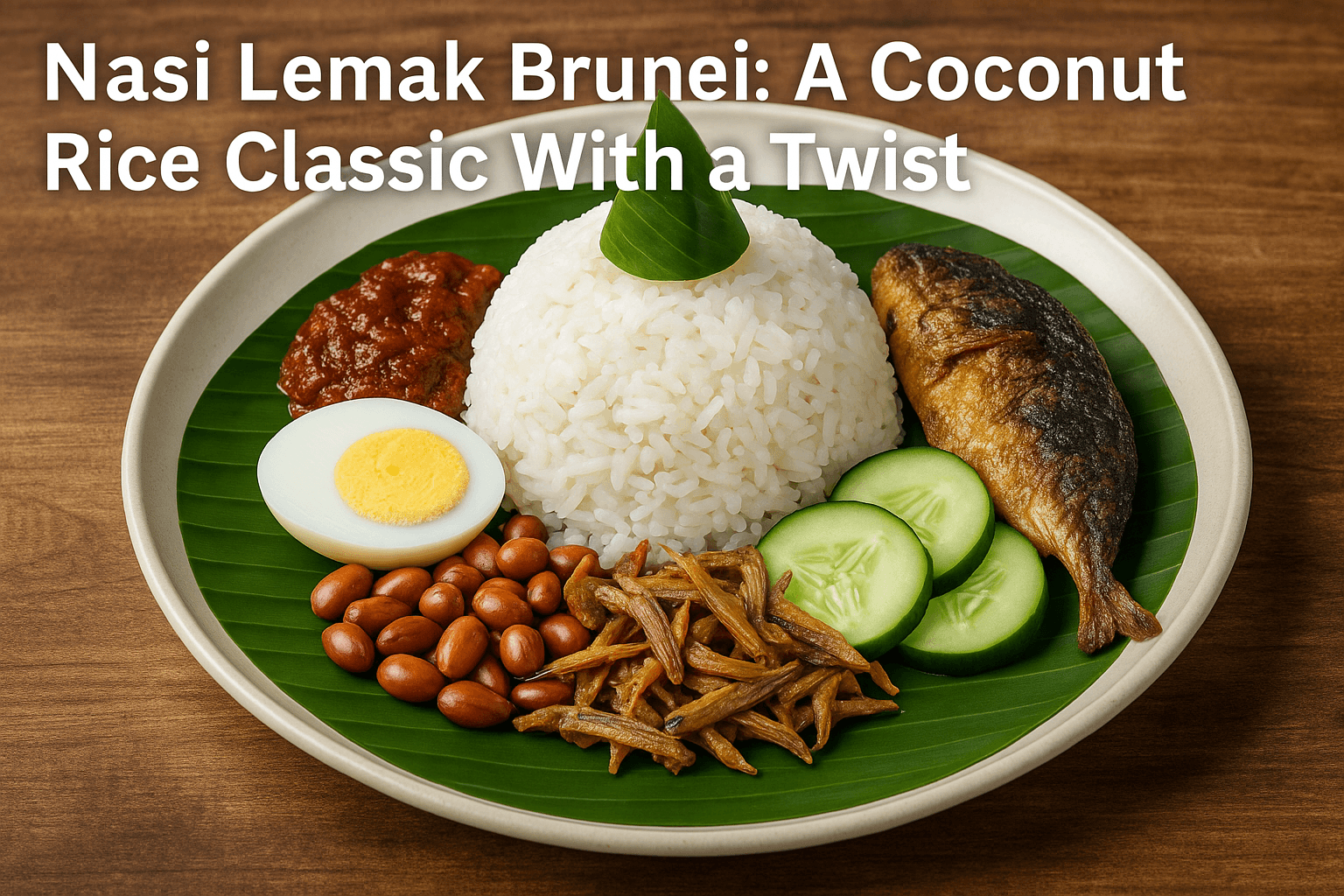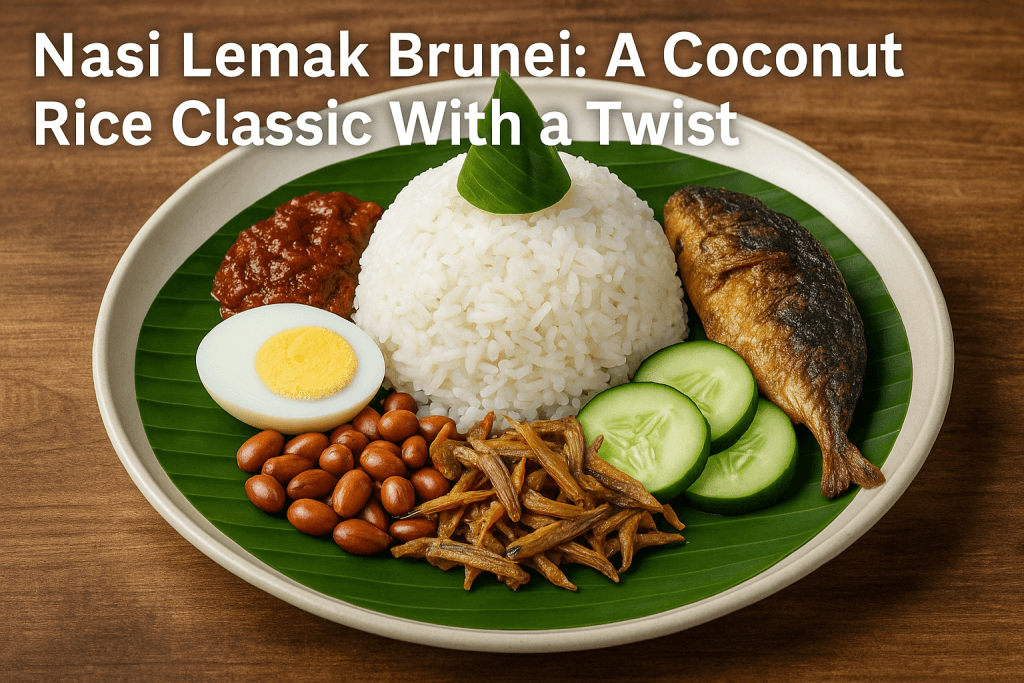Among the culinary gems of Southeast Asia, Nasi Lemak Brunei: A Coconut Rice Classic With a Twist shines as a symbol of tradition, flavor, and cultural fusion. While nasi lemak is deeply associated with Malaysia and Singapore, the Brunei interpretation carries unique qualities that reflect the Sultanate’s history, heritage, and local identity. This dish, often seen as simple yet deeply satisfying, embodies the essence of comfort food with a distinctive Bruneian soul.
The balance of fragrant coconut rice, savory accompaniments, spicy sambal, and regional side dishes elevates this meal into more than just food—it becomes an experience that highlights Brunei’s rich culinary tapestry.
This comprehensive introduction to Nasi Lemak Brunei: A Coconut Rice Classic With a Twist will explore its origins, preparation, local variations, nutritional value, cultural significance, and role in modern Brunei cuisine.

Historical Roots of Nasi Lemak in Brunei
Regional Influences
The idea of coconut rice paired with spicy sambal traces back centuries across maritime Southeast Asia. Brunei, once a powerful trading hub, absorbed culinary traditions from neighboring Malaysia and Indonesia. Over time, the dish evolved to suit local tastes, adding elements distinct from its regional counterparts.
Bruneian Adaptation
The Brunei twist lies in subtleties: the choice of fish, the way sambal is prepared, the side dishes featuring local produce, and the inclusion of flavors influenced by Brunei’s coastal and forest resources.
The Core of Nasi Lemak Brunei
Coconut Rice
The foundation of Nasi Lemak Brunei: A Coconut Rice Classic With a Twist is the rice infused with rich coconut milk and pandan leaves. The fragrance sets the tone for the meal, offering a creamy yet delicate balance.
Sambal Brunei Style
Unlike Malaysian versions that lean heavily toward sweetness or heat, Bruneian sambal often strikes a middle ground. It may include dried shrimp, tamarind, or even anchovy flavors, providing depth and umami.
Traditional Accompaniments
Hard-boiled or fried egg
Fried anchovies
Peanuts
Cucumber slices
Brunei adds its own flair by incorporating grilled fish, beef rendang variations, or even satay as part of the ensemble.
Unique Bruneian Twists
Local Seafood
Being a coastal nation, Brunei frequently pairs nasi lemak with freshly caught fish or prawns. These seafood sides distinguish it from more land-based versions elsewhere.
Spices and Aromatics
Bruneian cooks may add lemongrass, galangal, or turmeric to infuse a subtler aromatic note into the rice or sambal.
Influence of Kampong Cooking
Village traditions emphasize simplicity with a rustic yet authentic touch. Banana leaves are often used for serving, enhancing aroma and presentation.
Cultural Role of Nasi Lemak Brunei
Everyday Comfort
In Brunei, nasi lemak is more than a breakfast food—it is consumed throughout the day. From street stalls to family gatherings, it appears as a staple comfort meal.
Symbol of Identity
The dish carries symbolic meaning, reflecting how Brunei blends regional culinary influences into a proudly local version. It serves as a soft reminder of the nation’s shared heritage with its neighbors while maintaining individuality.
Celebrations and Gatherings
During festive seasons and community events, Nasi Lemak Brunei: A Coconut Rice Classic With a Twist plays a starring role on communal dining tables.
Nutritional Value and Modern Adaptations
Balanced Meal
Coconut rice provides carbohydrates, sambal introduces vitamins from chilies, fish adds protein, and cucumbers contribute freshness. Together, they form a balanced and complete meal.
Modern Health Focus
Contemporary Brunei restaurants often adapt the dish to health-conscious audiences, offering brown rice, grilled proteins, and reduced-oil sambal.
Fusion in Restaurants
Upscale dining in Brunei experiments with nasi lemak, presenting it in deconstructed styles, or fusing it with international ingredients.
Nasi Lemak in the Context of Brunei’s Culinary Landscape
Coexistence With Ambuyat
While ambuyat remains the national dish, nasi lemak holds a strong complementary role. Locals enjoy both, reflecting the diversity of Brunei cuisine.
Street Food Appeal
Night markets in Bandar Seri Begawan often showcase nasi lemak stalls, where the aroma of coconut rice and sambal fills the air.
Tourism Attraction
For visitors, trying Nasi Lemak Brunei: A Coconut Rice Classic With a Twist becomes an essential culinary experience. It connects travelers with the local lifestyle and flavors.
Preparation Techniques
Rice Cooking
Steaming rice with coconut milk and pandan is an art requiring precision to achieve fluffiness without clumping.
Sambal Craft
The sambal is slow-cooked, allowing chilies, shallots, garlic, and shrimp paste to meld together into a balanced spicy-sweet-savory condiment.
Presentation
Served traditionally on banana leaves, the dish captures authenticity while enhancing aroma. Modern eateries may present it on plates with decorative garnishes.
Variations Across Brunei
Coastal Versions
Featuring grilled fish, squid sambal, or prawns.
Inland Versions
Relying on chicken, beef rendang, or vegetable sides.
Modern Café Versions
Deconstructed platters where each element is separately styled, catering to international audiences.
Symbolism in Brunei Society
Representation of Togetherness
Sharing Nasi Lemak Brunei: A Coconut Rice Classic With a Twist often symbolizes unity at the table, reflecting Bruneian values of family and hospitality.
Culinary Diplomacy
The dish also works as a cultural ambassador, representing Brunei in regional food festivals.
Global Recognition
As Brunei’s tourism campaigns grow, nasi lemak increasingly garners global interest. International food bloggers and travel writers highlight the Brunei version as a must-try, solidifying its place in the world of Southeast Asian cuisine.
Conclusion
Nasi Lemak Brunei: A Coconut Rice Classic With a Twist stands as a culinary icon that embodies both tradition and innovation. Rooted in heritage yet adapted to modern tastes, it represents Brunei’s ability to honor cultural history while embracing creativity.
Through its fragrant coconut rice, balanced sambal, and diverse accompaniments, this dish captures the spirit of Brunei—welcoming, flavorful, and authentically unique. Whether enjoyed at a bustling night market, a village gathering, or an upscale restaurant, it remains an essential symbol of Bruneian culinary culture.

